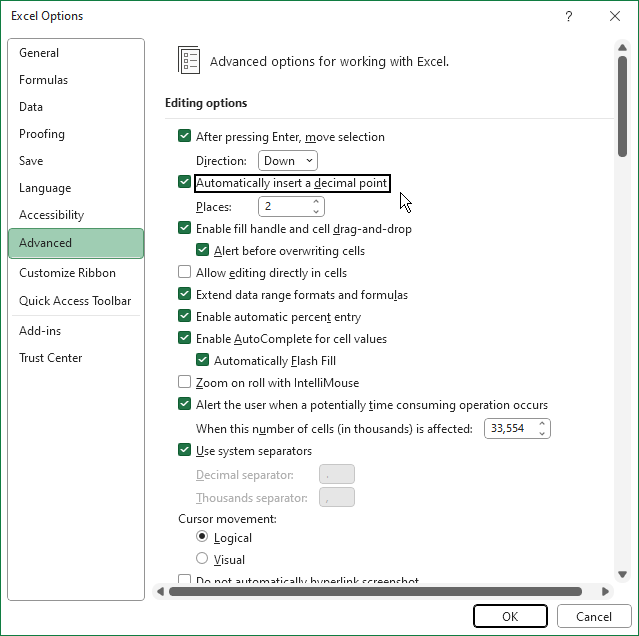Please Note: This article is written for users of the following Microsoft Excel versions: 2007, 2010, 2013, 2016, 2019, 2021, and Excel in Microsoft 365. If you are using an earlier version (Excel 2003 or earlier), this tip may not work for you. For a version of this tip written specifically for earlier versions of Excel, click here: Fixing the Decimal Point.
Written by Allen Wyatt (last updated February 4, 2023)
This tip applies to Excel 2007, 2010, 2013, 2016, 2019, 2021, and Excel in Microsoft 365
Most electronic calculators have an option that allows you to specify a fixed location for a decimal point. This comes in real handy when you are working with dollars and cents, for instance. With the decimal point fixed at two places, you can enter "213" and have the calculator translate it as "2.13". Likewise, if you enter "2", the calculator translates it as "0.02".
Excel has a feature that allows you to do the same thing. To fix the number of decimal places assumed when inputting information, follow these steps:

Figure 1. The advanced options of the Excel Options dialog box.
Remember that this control only affects any new values that you enter into a cell. It does not affect any values entered previously. Thus, if a cell already contains the value 1.2345, then changing the setting to 2 decimal places will not change the value to 1.23 or 123.45.
It also only affects new values entered where you don't include a decimal point. Thus, if you have the decimal places set to 2 and you enter "1.2345" (with the decimal point), then the value entered will include the four decimal places.
ExcelTips is your source for cost-effective Microsoft Excel training. This tip (7565) applies to Microsoft Excel 2007, 2010, 2013, 2016, 2019, 2021, and Excel in Microsoft 365. You can find a version of this tip for the older menu interface of Excel here: Fixing the Decimal Point.

Best-Selling VBA Tutorial for Beginners Take your Excel knowledge to the next level. With a little background in VBA programming, you can go well beyond basic spreadsheets and functions. Use macros to reduce errors, save time, and integrate with other Microsoft applications. Fully updated for the latest version of Office 365. Check out Microsoft 365 Excel VBA Programming For Dummies today!
Some people like zero values displayed; others do not. Excel allows you to easily turn the display on or off for a single ...
Discover MoreExcel allows you to make a wide range of customizations to both the Quick Access Toolbar and the ribbon. If you want to ...
Discover MoreExcel allows you to specify where it stores various files used by the program. One location you can specify is where ...
Discover MoreFREE SERVICE: Get tips like this every week in ExcelTips, a free productivity newsletter. Enter your address and click "Subscribe."
2023-02-04 11:33:13
J. Woolley
My Excel Toolbox includes the FixedDecimal macro to enable or disable fixed decimal data entry. You can easily adjust the fixed decimal place (positive or negative) assigned to numbers entered without a decimal point.
My Excel Toolbox also includes the following function to return the fixed number of decimal places, or FALSE if that feature is disabled:
=FixedDecimalPlaces()
See https://sites.google.com/view/MyExcelToolbox/
For related discussion, see https://excelribbon.tips.net/T007563_Entered_Values_are_Divided_by_100.html
Got a version of Excel that uses the ribbon interface (Excel 2007 or later)? This site is for you! If you use an earlier version of Excel, visit our ExcelTips site focusing on the menu interface.
FREE SERVICE: Get tips like this every week in ExcelTips, a free productivity newsletter. Enter your address and click "Subscribe."
Copyright © 2026 Sharon Parq Associates, Inc.
Comments